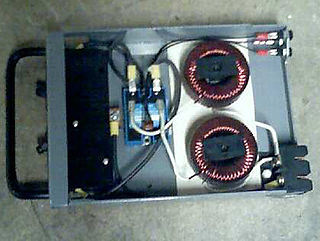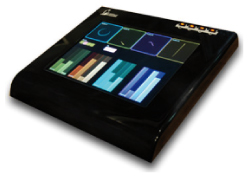
DMX512 is a standard for digital communication networks that are commonly used to control lighting and effects. It was originally intended as a standardized method for controlling stage lighting dimmers, which, prior to DMX512, had employed various incompatible proprietary protocols. It quickly became the primary method for linking controllers to dimmers and special effects devices such as fog machines and intelligent lights.
Open Sound Control (OSC) is a protocol for networking sound synthesizers, computers, and other multimedia devices for purposes such as musical performance or show control. OSC's advantages include interoperability, accuracy, flexibility and enhanced organization and documentation. Its disadvantages include inefficient coding of information, increased load on embedded processors, and lack of standardized messages/interoperability. The first specification was released in March 2002.

A dimmer is a device connected to a light fixture and used to lower the brightness of the light. By changing the voltage waveform applied to the lamp, it is possible to lower the intensity of the light output. Although variable-voltage devices are used for various purposes, the term dimmer is generally reserved for those intended to control light output from resistive incandescent, halogen, and compact fluorescent lamps (CFLs) and light-emitting diodes (LEDs). More specialized equipment is needed to dim fluorescent, mercury-vapor, solid-state, and other arc lighting.

A lighting control console is an electronic device used in theatrical lighting design to control multiple stage lights at once. They are used throughout the entertainment industry and are normally placed at the front of house (FOH) position or in a control booth.
An output device is any piece of computer hardware that converts information/DATA into a human-perceptible form or, historically, into a physical machine-readable form for use with other non-computerized equipment. It can be text, graphics, tactile, audio, or video. Examples include monitors, printers, speakers, headphones, projectors, GPS devices, optical mark readers, and braille readers.
x11vnc is a Virtual Network Computing (VNC) server program. It allows remote access from a remote client to a computer hosting an X Window session and the x11vnc software, continuously polling the X server's frame buffer for changes. This allows the user to control their X11 desktop from a remote computer either on the user's own network, or from over the Internet as if the user were sitting in front of it. x11vnc can also poll non-X11 frame buffer devices, such as webcams or TV tuner cards, iPAQ, Neuros OSD, the Linux console, and the Mac OS X graphics display. x11vnc is part of the LibVNCServer project and is free software available under the GNU General Public License. x11vnc was written by Karl Runge.

A terminal server connects devices with a serial port to a local area network (LAN). Products marketed as terminal servers can be very simple devices that do not offer any security functionality, such as data encryption and user authentication. The primary application scenario is to enable serial devices to access network server applications, or vice versa, where security of the data on the LAN is not generally an issue. There are also many terminal servers on the market that have highly advanced security functionality to ensure that only qualified personnel can access various servers and that any data that is transmitted across the LAN, or over the Internet, is encrypted. Usually, companies that need a terminal server with these advanced functions want to remotely control, monitor, diagnose and troubleshoot equipment over a telecommunications network.

Skype for Business Server is real-time communications server software that provides the infrastructure for enterprise instant messaging, presence, VoIP, ad hoc and structured conferences and PSTN connectivity through a third-party gateway or SIP trunk. These features are available within an organization, between organizations and with external users on the public internet or standard phones.

Show control is the use of automation technology to link together and operate multiple entertainment control systems in a coordinated manner. It is distinguished from an entertainment control system, which is specific to a single theatrical department, system or effect, one which coordinates elements within a single entertainment discipline such as lighting, sound, video, rigging, or pyrotechnics. A typical entertainment control system would be a lighting control console. An example of show control would be linking a video segment with a number of lighting cues, or having a sound cue trigger animatronic movements, or all of these combined. Shows with or without live actors can almost invariably incorporate entertainment control technology and usually benefit from show control to operate these subsystems independently, simultaneously, or in rapid succession.
Remote Device Management(RDM) is an addition to the DMX512 control protocol for stage lighting equipment, introduced in 2006. DMX512 was developed in the late 1980s as a standard protocol for lighting consoles to communicate with dimmers, but has since been used for more complex applications, including the control of intelligent lighting fixtures. The addition of RDM addresses many of the shortcomings of DMX512, which is unidirectional with no support for metadata.

Intelligent lighting refers to lighting that has automated or mechanical abilities beyond those of traditional, stationary illumination. Although the most advanced intelligent lights can produce extraordinarily complex effects, the intelligence lies with the human lighting designer, control system programmer(For example, Chamsys and Avolites), or the lighting operator, rather than the fixture itself. For this reason, intelligent lighting (ILS) is also known as automated lighting, moving lights, moving heads, or simply movers.
A media server is a computer appliance or an application software that stores digital media and makes it available over a network.

The Lemur was a highly customizable multi-touch device from French company JazzMutant founded by Yoann Gantch, Pascal Joguet, Guillaume Largillier and Julien Olivier in 2002, which served as a controller for musical devices such as synthesizers and mixing consoles, as well as for other media applications such as video performances. As an audio tool, the Lemur's role was equivalent to that of a MIDI controller in a MIDI studio setup, except that the Lemur used the Open Sound Control (OSC) protocol, a high-speed networking replacement for MIDI. The controller was especially well-suited for use with Reaktor and Max/MSP, tools for building custom software synthesizers.
A colour scroller or colour changer is an electro-mechanical lighting accessory used in theater, film, dance and concerts to change the colour projected by stage lighting instruments without the need of a person to be in the vicinity of the light. A colour scroller moves plastic "gel" colour gel [actually dyed polyester and/or other base materials coated with dyes] into the beam of the light. It is generally attached to the gel frame holder at the transmitting end of a lighting fixture, so colour is introduced after the beam characteristics have been defined by the optics of the lighting instrument. Most scrollers are controlled via DMX512 protocol, but some models also utilize the RDM protocol. When colour scrollers were first introduced around 1980, a number of companies produced them, including: Avolites, GAM Products, Morpheus Lights, Rainbow, Rosco Laboratories and Wybron Inc. Now the main manufacturers are: A.C. Lighting, Apollo, Morpheus Lights and Rainbow.
A home server is a computing server located in a private computing residence providing services to other devices inside or outside the household through a home network or the Internet. Such services may include file and printer serving, media center serving, home automation control, web serving, web caching, file sharing and synchronization, video surveillance and digital video recorder, calendar and contact sharing and synchronization, account authentication, and backup services.
LinuxMCE is a free and open source software platform with a 10-foot user interface designed to allow a computer to act as a home theater PC (HTPC) for the living-room TV, personal video recorder, and home automation system. It allows control of everything in the home, from lighting and climate to surveillance cameras and home security. It also includes a full-featured VoIP-compatible phone system with support for video conferencing.
Remote Desktop Services (RDS), known as Terminal Services in Windows Server 2008 and earlier, is one of the components of Microsoft Windows that allow a user to initiate and control an interactive session on a remote computer or virtual machine over a network connection. RDS was first released in 1998 as Terminal Server in Windows NT 4.0 Terminal Server Edition, a stand-alone edition of Windows NT 4.0 Server that allowed users to log in remotely. Starting with Windows 2000, it was integrated under the name of Terminal Services as an optional component in the server editions of the Windows NT family of operating systems, receiving updates and improvements with each version of Windows. Terminal Services were then renamed to Remote Desktop Services with Windows Server 2008 R2 in 2009.
Art-Net is a royalty-free communications protocol for transmitting the DMX512-A lighting control protocol and Remote Device management (RDM) protocol over the User Datagram Protocol (UDP) of the Internet protocol suite. It is used to communicate between "nodes" and a "server".
A headless computer is a computer system or device that has been configured to operate without a monitor, keyboard, and mouse. A headless system is typically controlled over a network connection, although some headless system devices require a serial connection to be made over RS-232 for administration of the device. Headless operation of a server is typically employed to reduce operating costs.

QLab is a cue-based, multimedia playback software package for macOS, intended for use in theatre and live entertainment. It is developed by Figure 53, an American company based in Baltimore, Maryland.








